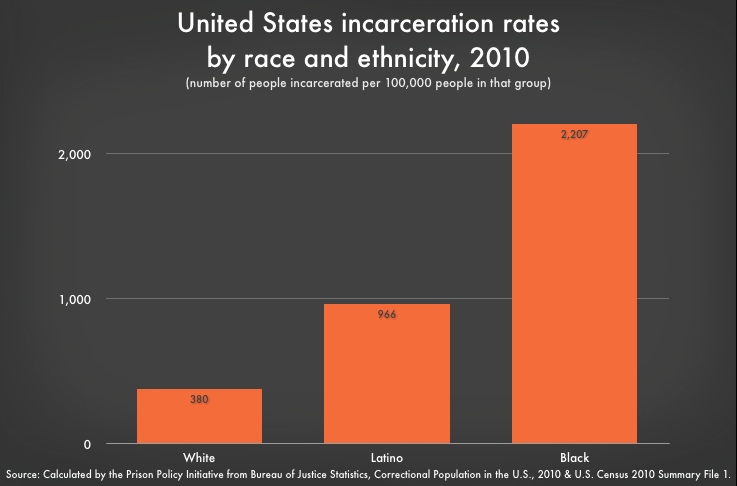U.S. prison statistics
In the United States in 2008, 739 per 100,000 population were either serving time, awaiting trial, or otherwise detained. Local jails held 785,556 persons awaiting trial or serving a sentence at midyear 2008. An additional 72,852 persons under jail supervision were serving their sentence in the community.[4] Ninety percent of jail inmates were adult males, although the number of adult females in jail increased faster than adult males.
Differences by ethnic group are quite apparent in the U.S. prison population: 4,777 black male inmates per 100,000 black males compared with 1,760 Hispanic male inmates per 100,000 Hispanic males and 727 white male inmates per 100,000 white males.[5]
Although these statistics refer to the adult prison population, juvenile crime has increased substantially over the past decade. According to the Federal Bureau of Investigation (FBI), juveniles accounted for 17 percent of all arrests, while 15 percent of those arrests were considered violent crimes, and juvenile arrest for drug abuse violations increased considerably. Females made up 28 percent of the total of juvenile arrests.
The arrest rates are substantially different for young males compared to females for simple assault charges; young males were accountable for 8 percent of the statistics, whereas young females were arrested in 58 percent of assault cases. There appeared to be a significant increase among young female simple assault arrests as well as for aggravated assaults.
According to the U.S. Bureau of Justice Statistics (BJS) 7,225,800 people at yearend 2010 were on probation, in jail or prison, or on parole — about 3.1% of adults in the U.S. resident population.
2,297,400 were incarcerated in U.S. prisons and jails. The U.S. incarceration rate was 748 inmates per 100,000 U.S. residents, or 0.75%.
The USA has the highest total documented prison and jail population in the world.
Prison Health Care
- Prison Health Care
- The Purpose of prisons
- Medical problems of prisoners
- U.S. prison statistics
- Sexual Victimization
- HIV/AIDS in prisons
- Mental Health of Prisoners
- Substance Abuse in prisoners
- How should prison health care be provided?
- Prison Health Care Conclusion
- check also - HIV Transmission and Prevention in Prisons
If recent incarceration rates in America remain unchanged, an estimated 1 of every 15 persons (6.6 percent) will serve time in a prison during their life. Lifetime chances of a person going to prison are higher for men (11.3 percent) than for women (1.8 percent), and for blacks (18.6 percent) and Hispanics (10 percent) than for whites (3.4 percent). Based on current rates of first incarceration, an estimated 32 percent of black males will enter state or federal prison during their lifetime, compared with 17 percent of Hispanic males and 5.9 percent of white males.[6]
 U.S. incarceration rates by race, June 30, 2004
U.S. incarceration rates by race, June 30, 2004
These data are based on prisoners under the jurisdiction of federal or state correctional authorities on June 30, 2008, collected from the National Prisoner Statistics series.
###
Madelon L. Finkel, PhD
Madelon L. Finkel, PhD, is professor of clinical public health and director of the Office of Global Health Education at the Weill Cornell Medical College in New York City, NY. Dr Finkel is an epidemiologist whose work focuses on women’s health issues. Her interests also include global public health issues with ongoing research projects in rural India and Peru. Dr. Finkel has published extensively, including Praeger’s Understanding the Mammography Controversy: Science, Politics, and Breast Cancer Screening and Truth, Lies, and Public Health: How We Are Affected When Science and Politics Collide.
###
REFERENCES
- Walmsley R. World prison population list. 7th ed.
- Wikipedia. Prisoner population rate 2007-2008.
- Mauer M. Comparative international rates of incarceration: an examination of causes and trends: Presented to the US Commission on Civil Rights; June 20, 2003; Washington, DC.
- US Department of Justice, Bureau of Justice Statistics, Office of Justice Programs. Correction statistics.
- Ibid.
- Federal Bureau of Investigation. FBI uniform crime report.
- Maruschak LM for US Department of Justice, Bureau of Justice Statistics, Office of Justice Programs. Medical problems of prisoners.
- Griefinger RB, Heywood NJ, Glaser JB. Tuberculosis in prison: balancing justice and public health. J Law Med Ethics. 1993;21:332-341.
- World Health Organization. Tuberculosis in prisons.
- Shalit M, Lewin MR. Medical care of prisoners in the USA. Lancet. 2004;364:34-35.